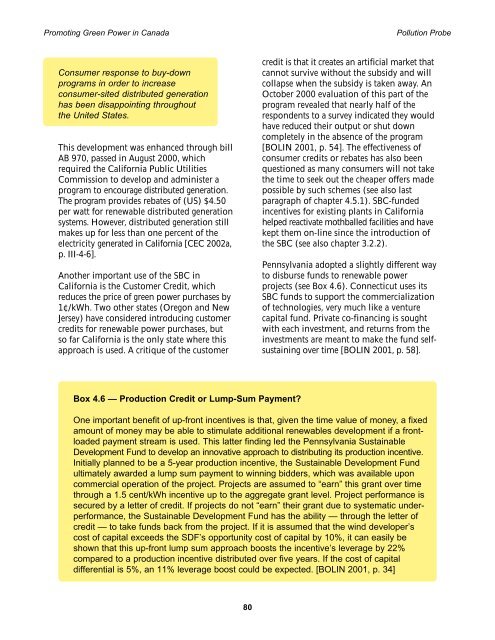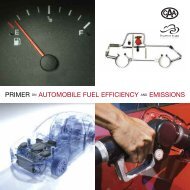Promoting Green Power in Canada - Centre for Human Settlements
Promoting Green Power in Canada - Centre for Human Settlements
Promoting Green Power in Canada - Centre for Human Settlements
- No tags were found...
You also want an ePaper? Increase the reach of your titles
YUMPU automatically turns print PDFs into web optimized ePapers that Google loves.
<strong>Promot<strong>in</strong>g</strong> <strong>Green</strong> <strong>Power</strong> <strong>in</strong> <strong>Canada</strong> Pollution ProbeConsumer response to buy-downprograms <strong>in</strong> order to <strong>in</strong>creaseconsumer-sited distributed generationhas been disappo<strong>in</strong>t<strong>in</strong>g throughoutthe United States.This development was enhanced through billAB 970, passed <strong>in</strong> August 2000, whichrequired the Cali<strong>for</strong>nia Public UtilitiesCommission to develop and adm<strong>in</strong>ister aprogram to encourage distributed generation.The program provides rebates of (US) $4.50per watt <strong>for</strong> renewable distributed generationsystems. However, distributed generation stillmakes up <strong>for</strong> less than one percent of theelectricity generated <strong>in</strong> Cali<strong>for</strong>nia [CEC 2002a,p. III-4-6].Another important use of the SBC <strong>in</strong>Cali<strong>for</strong>nia is the Customer Credit, whichreduces the price of green power purchases by1¢/kWh. Two other states (Oregon and NewJersey) have considered <strong>in</strong>troduc<strong>in</strong>g customercredits <strong>for</strong> renewable power purchases, butso far Cali<strong>for</strong>nia is the only state where thisapproach is used. A critique of the customercredit is that it creates an artificial market thatcannot survive without the subsidy and willcollapse when the subsidy is taken away. AnOctober 2000 evaluation of this part of theprogram revealed that nearly half of therespondents to a survey <strong>in</strong>dicated they wouldhave reduced their output or shut downcompletely <strong>in</strong> the absence of the program[BOLIN 2001, p. 54]. The effectiveness ofconsumer credits or rebates has also beenquestioned as many consumers will not takethe time to seek out the cheaper offers madepossible by such schemes (see also lastparagraph of chapter 4.5.1). SBC-funded<strong>in</strong>centives <strong>for</strong> exist<strong>in</strong>g plants <strong>in</strong> Cali<strong>for</strong>niahelped reactivate mothballed facilities and havekept them on-l<strong>in</strong>e s<strong>in</strong>ce the <strong>in</strong>troduction ofthe SBC (see also chapter 3.2.2).Pennsylvania adopted a slightly different wayto disburse funds to renewable powerprojects (see Box 4.6). Connecticut uses itsSBC funds to support the commercializationof technologies, very much like a venturecapital fund. Private co-f<strong>in</strong>anc<strong>in</strong>g is soughtwith each <strong>in</strong>vestment, and returns from the<strong>in</strong>vestments are meant to make the fund selfsusta<strong>in</strong><strong>in</strong>gover time [BOLIN 2001, p. 58].Box 4.6 — Production Credit or Lump-Sum Payment?One important benefit of up-front <strong>in</strong>centives is that, given the time value of money, a fixedamount of money may be able to stimulate additional renewables development if a frontloadedpayment stream is used. This latter f<strong>in</strong>d<strong>in</strong>g led the Pennsylvania Susta<strong>in</strong>ableDevelopment Fund to develop an <strong>in</strong>novative approach to distribut<strong>in</strong>g its production <strong>in</strong>centive.Initially planned to be a 5-year production <strong>in</strong>centive, the Susta<strong>in</strong>able Development Fundultimately awarded a lump sum payment to w<strong>in</strong>n<strong>in</strong>g bidders, which was available uponcommercial operation of the project. Projects are assumed to “earn” this grant over timethrough a 1.5 cent/kWh <strong>in</strong>centive up to the aggregate grant level. Project per<strong>for</strong>mance issecured by a letter of credit. If projects do not “earn” their grant due to systematic underper<strong>for</strong>mance,the Susta<strong>in</strong>able Development Fund has the ability — through the letter ofcredit — to take funds back from the project. If it is assumed that the w<strong>in</strong>d developer’scost of capital exceeds the SDF’s opportunity cost of capital by 10%, it can easily beshown that this up-front lump sum approach boosts the <strong>in</strong>centive’s leverage by 22%compared to a production <strong>in</strong>centive distributed over five years. If the cost of capitaldifferential is 5%, an 11% leverage boost could be expected. [BOLIN 2001, p. 34]80
















